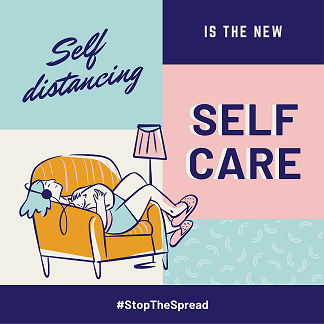Even if you’re doing everything right, like whaling your hands and practicing social distancing, you may still find yourself in a situation where you’re concerned you’ve been exposed to coronavirus (COVID-19).
You don’t feel sick or have symptoms, but maybe you work in the same office as someone who is a confirmed COVID-19 case, attended a party or large gathering where someone was later confirmed to be positive for COVID-19 or traveled in an airplane seated next to someone who was coughing. Understandably, you’re concerned.
An epidemic is a good time to be on high alert, but self-quarantining is only necessary if you’re reasonably suspect that you’re infected with the virus. Public health officials can help you decide what you should do.
Since it can be disruptive to your personal and professional life, the decision to self-quarantine isn’t one to make without knowing the facts. Here’s what you need to know about who should self-quarantine and how to do it right.
Who should self-quarantine
The Centers for Disease Control and Prevention (CDC) recommends self-quarantining if you have a high or medium risk of exposure to the new coronavirus.
You’re at high risk of exposure to COVID-19 if you:
- Live with, are intimate with or care for someone who has symptomatic COVID-19 and you haven’t followed the recommended precautionary steps to prevent transmission of the virus
You’re at medium risk of exposure to the new coronavirus if you:
- Have traveled from a country with widespread or ongoing community spread
- Travel on a cruise ship
- Have come into close contact with someone who has a confirmed case of COVID-19 and is symptomatic (close contact means two seats in either direction on an airplane)
- Live with, are intimate with or care for someone who has symptomatic COVID-19 and you have consistently followed the recommended precautionary steps to prevent transmission of the virus
If you’re healthy, don’t have any symptoms and don’t fall into one of the risk categories above, you don’t need to self-quarantine — but you should continue to practice social distancing and monitor yourself for signs and symptoms, like fever and cough.
How to self-quarantine
Based on what’s currently known about how long symptoms last, the recommended length of quarantine is 14 days. The goal is to prevent potentially spreading the virus by separating yourself from other people long enough to determine whether or not you’re infected and showing symptoms.
The CDC recommends taking the following steps to help prevent the spread of COVID-19:
Don’t leave your house unless absolutely necessary
You’ll need to restrict your activities outside of your home, including going to school, work, public areas or using public transportation. Only leave the house if you need to see your doctor and you have called ahead to discuss and plan your appointment.
Separate yourself from the people and pets you share your home with
If possible, stay in a separate room and use a separate bathroom. While there are no reports of transmission of the new coronavirus to pets, it’s recommended that you limit contact with animals until more is known about the virus.
Wash your hands often
Practicing proper hand hygiene can help prevent the spread of the virus. Wash your hands after blowing your nose, sneezing or coughing. In addition, avoid touching your face.
Don’t share your stuff
Avoid sharing the following items with people or animals in your home:
- Bedding
- Dishes, drinking glasses and utensils
- Towels, including hand towels in the kitchen and bathroom
Disinfect commonly touched surfaces every day
Early evidence shows that the new coronavirus can live on surfaces — for hours or even days in some cases.
At least once per day, be sure to clean and disinfect commonly touched surfaces around your home, including:
- Bathroom fixtures
- Counters
- Doorknobs
- Keyboards
- Phones
Monitor your symptoms
Twice a day, take your temperature to check for a fever. Also, take note if you’re beginning to cough or experiencing shortness of breath.
You may or may not experience COVID-19 symptoms (coughing, fever, and shortness of breath) during your quarantine. If you do begin experiencing symptoms:
- Wear a mask when you’re around people or using common spaces in your home
- Cover your coughs and sneezes and immediately wash your hands afterward
- Contact your health care provider or use telemedicine to seek guidance from home
Use telemedicine or call ahead before seeing your doctor
If you begin experiencing symptoms and/or need medical advice from a health care provider, consider trying telemedicine first. If you need to go to your doctor’s office, let your care team know ahead of time that you may have COVID-19. This will help the team take the precautionary steps needed to protect other people from being exposed to the virus.
By carefully following these tips, along with guidance from the CDC and public health officials, you can help slow the spread of COVID-19 and protect your friends and loved ones, as well as those most at risk of severe infection.
Source:
- World Health Organization
- CDC ( Centers for Disease Control and Prevention )


